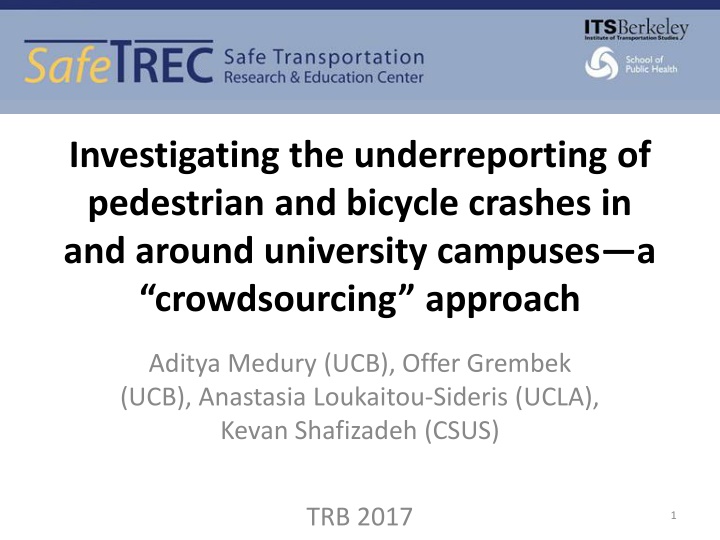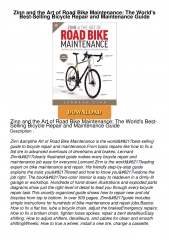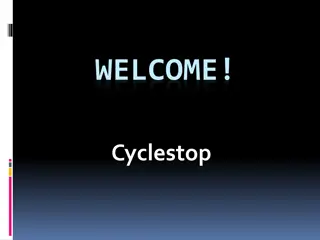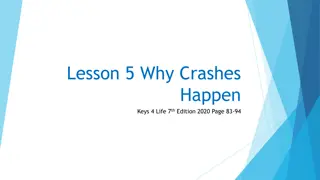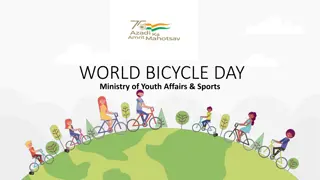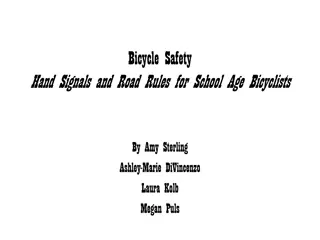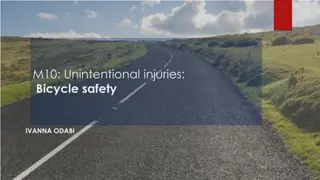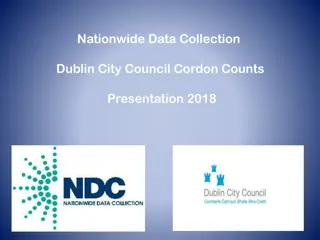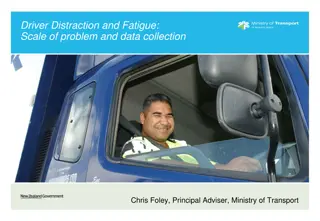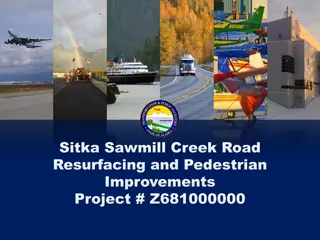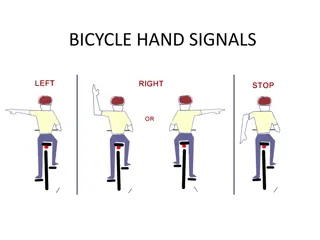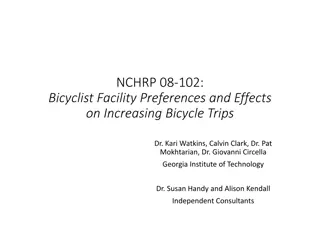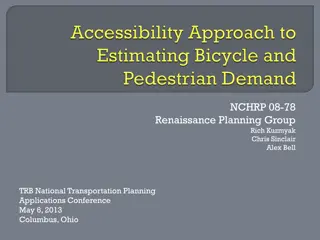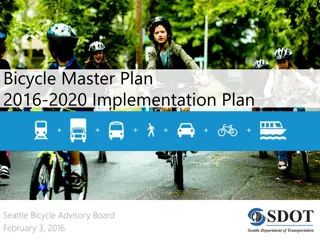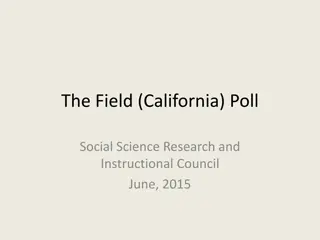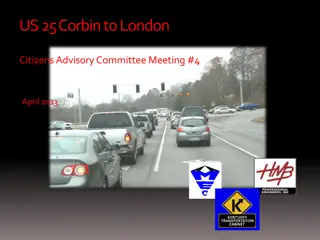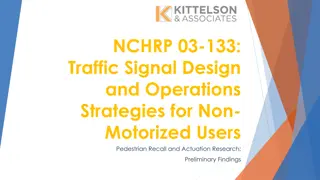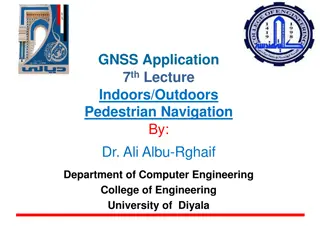Investigating Underreporting of Pedestrian and Bicycle Crashes Around University Campuses
This study explores the underreporting of pedestrian and bicycle crashes in and around university campuses using a crowdsourcing approach. It discusses the reasons why not all crashes get documented and how crowdsourced data can complement police-reported datasets, providing insights into perceptions of traffic safety.
Download Presentation

Please find below an Image/Link to download the presentation.
The content on the website is provided AS IS for your information and personal use only. It may not be sold, licensed, or shared on other websites without obtaining consent from the author.If you encounter any issues during the download, it is possible that the publisher has removed the file from their server.
You are allowed to download the files provided on this website for personal or commercial use, subject to the condition that they are used lawfully. All files are the property of their respective owners.
The content on the website is provided AS IS for your information and personal use only. It may not be sold, licensed, or shared on other websites without obtaining consent from the author.
E N D
Presentation Transcript
Investigating the underreporting of pedestrian and bicycle crashes in and around university campuses a crowdsourcing approach Aditya Medury (UCB), Offer Grembek (UCB), Anastasia Loukaitou-Sideris (UCLA), Kevan Shafizadeh (CSUS) TRB 2017 1
Why Crowdsource Traffic Safety Data? Leveraging traffic safety information from the community at large 2
Not all crashes get documented A crash is less likely to get reported to the police if: Only/predominantly non-motorized modes involved No injured parties/little property damage Only one party involved [Elvik and Mysen, 1999; Stutts and Hunter, 1998; Sciortino et al, 2005; Loo and Tsui, 2007] 3
But people observe these crashes (from personal experience) A minor read-end collision involving me. No injuries, minor property damage. Got reported on Waze (not by me), and validated by three other people. Source: Waze 4
People also have opinions about traffic safety Source: Nextdoor.com 5
Traffic Safety Management (using police-reported datasets) Historical Police- reported Crashes Crashes Occurring in the Future Trying to mitigate future crashes using historical crashes
Understanding crowdsourced crash data Historical Police- reported Crashes Crashes Occurring in the Future Crowdsourced/Self- reported Crashes Perceptions of Traffic Safety In what ways do crowdsourced data supplement, and differ from, police-reported crashes?
Perceptions vs Crashes Historical Police- reported Crashes Crashes Occurring in the Future Crowdsourced/Self- reported Crashes Perceptions of Traffic Safety How well do traffic perceptions align with crash data?
Sourcing Safety Data from Campus Community Three university campuses studied: California State University, Sacramento (CSUS) University of California, Berkeley (UCB) University of California, Los Angeles (UCLA) Administered an online survey between Feb and March 2013 at each campus: Campus community contacted via official e-mail addresses Two types of pedestrian and bicycle safety data requested: Previous crash experiences Perceived hazardous locations 9
Evaluating Four Types of Traffic Safety Data OFF-CAMPUS ANALYSIS SWITRS Crashes (Jan 2010- Mar 2013) Survey Crashes (Jan 2010- Mar 2013) Perceived Hazardous Locations (PHL) (Feb-Mar 2013) Post-Survey SWITRS Crashes (Apr 2013-Dec 2015) Campus CSUS 49 15 168 27 UCB UCLA 196 110 125 81 1383 1354 196 88 Very few police-reported crashes (SWITRS) observed on campus 10
What are the similarities and differences in these datasets? Historical SWITRS Crashes Post-Survey SWITRS Crashes Self-Reported Crashes Perceived Hazardous Locations
Comparing Historical SWITRS and Survey Crashes 12
Self-reported Crashes Less Auto- Dominant 100% 90% 80% 70% 60% 50% 40% 30% 20% 10% 0% Survey (Off- Campus) SWITRS Survey (Off- Campus) SWITRS Survey (Off- Campus) SWITRS CSUS UCB UCLA Ped Bicycle Auto Others A greater diversity in crash types observed in survey (more ped-bicycle, single bicycle crashes) 13
Many survey-reported crashes involved no injuries 100% 80% 60% 40% 20% 0% Survey (Off- Campus) SWITRS Survey (Off- Campus) SWITRS Survey (Off- Campus) SWITRS CSUS UCB UCLA Severe Minor No Injury I was looking to my left to see oncoming traffic before making a right turn onto Ohio. Lifted my foot from the brake briefly - was not aware that there was a woman with a stroller right in front of me in crosswalk. Tapped stroller, which slowly fell over. 14
Campus Boundary Effect SWITRS UCLA Survey (Off-Campus) SWITRS UCB Survey (Off-Campus) SWITRS CSUS Survey (Off-Campus) 0% 10% 20% 30% 40% 50% 60% 70% 80% % of crashes within 200 m of campus boundary % of crashes within 100 m of campus boundary Campus boundary lies at the interface of non-motorized-friendly on- campus environment and automobile-friendly off-campus city traffic. In UCB and CSUS, on-campus access to motorists is significantly restricted. 15
Understanding Perceived Hazardous Locations (PHLs) Identifying spatial overlaps with both historical and future crashes 16
Identifying Clusters of Significance Using PHLs/SWITRS crash locations as points of reference, aggregated all crash/PHLs around them within 50 meters. Distinguishing between clusters with high PHLs and low PHLs (threshold = 20 observations) 17
High concentrations of PHLs overlapped with future SWITRS crashes UCB Average Distance of the Point of Reference from Campus (meters) Average of Post-Survey SWITRS Crashes per Group Average of Historical SWITRS Crashes per Group Average of Total Number of Crashes per Group Average of Survey Crashes per Group Number of Groups Average of PHLs per Group Types of PHL Groups <=20 245.69 (203.55) 144 0.85 (0.85) 0.89 (1.31) 0.53(0.95) 3.49 (3.94) 2.28 (2.47) observations >20 40.29 (13.94) 7 2.29 (0.95) 1.86 (1.57) 3 (2.45) 7.14 (2.12) 26.36 (9.85) observations Two-Sample Kolmogorov-Smirnov Test at 5% Significance Yes No Yes Yes Yes Yes Could high concentrations of PHLs act as a means of validating self- reported data? 18
High concentrations of PHLs overlapped with future SWITRS crashes UCLA Average Distance of the Point of Reference from Campus (meters) Average of Post-Survey SWITRS Crashes per Group Average of Historical SWITRS Crashes per Group Average of Total Number of Crashes per Group Average of Survey Crashes per Group Number of Groups Average of PHLs per Group Types of PHL Groups <=20 384.77 (434.10) 173 0.50 (0.78) 0.43 (0.79) 0.38 (0.76) 3.81 (3.87) 1.31 (1.81) observations >20 439.27 (240.07) 7 1.14 (0.69) 1.86 (1.07) 2.14 (1.35) 27 (6.68) 5.14 (1.35) observations Two-Sample Kolmogorov-Smirnov Test at 5% Significance Yes Yes Yes Yes Yes No 19
What have we learnt? People are forthcoming with information on traffic safety Insights gained from self-reported crashes may be complementary to police-reported databases People s perceptions of traffic safety may be helpful in detecting emerging concerns of traffic safety High concentrations of observations also useful as a method to alleviate concerns of data quality Continuous engagement with the community over prolonged periods of time would help substantiate the potential of crowdsourcing traffic safety data 20
Thank you! 21
Reporting Crash Data 1. Campus affiliation 2. Time of crash 3. Crash location (sidewalk, driveway, crosswalk, bicycle lane, etc.) 4. Objects involved (cyclist, pedestrian, vehicle, non-moving permanent object) 5. Injury severity (very serious to no injury, no property damage) 6. Potential contributing factors for each mode involved: 1. Behavior-related: inattention, excessive speed, failure to yield, etc. 2. Infrastructure-related: cracked sidewalk, obstructed bicycle lane, etc. 7. Whether the collision was reported or not 8. Crash narratives 22
Questions about Perceived Hazardous Locations Emphasis on proactive safety investigation 23
Four Types of Datasets Available SWITRS Crashes (Jan 2002- Mar 2013) Survey Crashes (<2002- Mar 2013) Perceived Hazardous Locations (Feb-Mar 2013) Post-Survey SWITRS Crashes (Apr 2013-Dec 2015) Campus CSUS 143 62 477 27 UCB UCLA 665 316 346 217 1769 2416 196 88 SWITRS (Statewide Integrated Traffic Records System): historical repository of all police-reported crashes in California Respondents more likely to report traffic safety perceptions 24
Majority of survey crashes occurred within 2-3 years of the survey 100% 90% 80% 70% 60% Jan Mar 2013 2012 2011 2010 Before 2010 N/A 50% 40% 30% 20% 10% 0% One-time retrospective study cannot capture a long time horizon equally effectively Large sections of campus community changes every four to five years 25
Comparing Off-Campus Crashes between Jan 2010 and Mar 2013 Time period commensurate with a typical four-year undergraduate cycle Limiting issues pertaining to recall bias in surveys Focusing only on off-campus crashes 26
But people observe these crashes Source: Twitter 27
Are the PHLs randomly dispersed? Or do high concentrations of PHLs overlap with other crash data? 28
A greater diversity of crashes documented in survey crashes 70% 60% 50% 40% 30% 20% 10% 0% Survey (Off- Campus) SWITRS Survey (Off- Campus) SWITRS Survey (Off- Campus) SWITRS CSUS UCB UCLA Ped-Bicycle Ped-Auto Bicycle-Auto Bicycle-Other Bicycle-Bicycle 29
